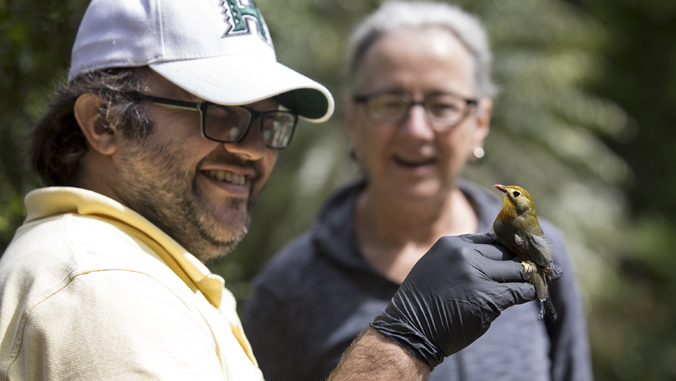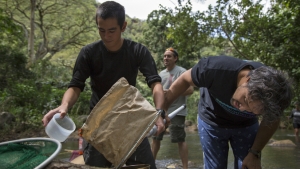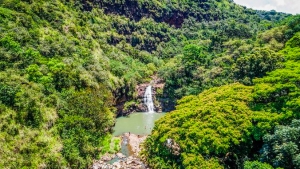
World-renowned microbiome research at the University of Hawaiʻi at Mānoa received a major boost by the National Science Foundation.
The five-year, $2,499,432 grant will support new research led by School of Life Sciences Professor Anthony Amend and his team to study how microbiomes influence food chains, which may lead to the creation of more efficient food webs that can potentially increase yield in agriculture, aquaculture and biofuels systems. This is the latest project in a storied history of groundbreaking microbiome research at UH Mānoa, spearheaded by Margaret McFall-Ngai, who joined the Carnegie Institution for Sciences in January 2022.
Food chains are inherently inefficient with major and predictable losses of energy due to waste and respiration. Research on food webs has mainly focused on the interactions among plants and animals. However, microbes (microorganisms such as bacteria and fungi) living in and on larger organisms play important roles in their health, rates of reproduction and ability to digest food.

The UH Mānoa project will examine how symbiotic microbes contribute to the efficiency of food webs, and how food webs determine the composition of symbiotic microbes. Results may indicate methods to manipulate the composition of microbes to create more efficient food webs that can potentially guide restoration of degraded habitats, capture carbon, and increase yield in agriculture, aquaculture and biofuels systems.
“Every time an animal eats a plant or another animal, about 90% of the energy of that food item escapes in the form of heat, while only the remaining 10% is transferred as biomass,” said Amend, who is the project’s principal investigator. “This inefficiency is one of the most steadfast rules of life, and is the reason there are comparatively few predators like sharks and lions in nature, but lots of plants and plant-eaters. We now know that symbiotic microbes living inside plants and animals can profoundly affect their ability to digest different types of food. If we can manipulate those microbes to change the efficiency with which food is converted to biomass—even by a small percentage—it could have tremendous impacts on our ability to manage complicated biological systems on which we rely, like watersheds and food systems.”
Amend added, “There has been a lot of great work on how microbiomes impact a single animal or plant, so we decided to scale that up to an entire ecosystem. It’s wild to think that the smallest living things can have the biggest impacts.”
Also on the research team are Pacific Biosciences Research Center (PBRC) Assistant Professor Matthew Medeiros, PBRC Associate Professor Nicole Hynson and Department of Information and Computer Sciences Assistant Professor Peter Sadowski.
Advancing microbiome research in Waimea Valley

This project builds on previous research conducted in Waimea Valley that indicated the surprising extent to which symbiotic microbes were shared amongst plants, animals, soils and sediments. This high degree of overlap among microbiomes across an entire watershed indicated that even unrelated organisms were reliant on each other as sources of critical microbial diversity. A commentary on the research was published in Science and Amend presented the findings at an Ecological Society of America meeting in August 2019.
Focus of research
Leveraging a model Hawaiian watershed system, this project aims to understand how host-associated microbiomes govern food chain efficiency and how, in turn, position within a food web affects the microbiome. Two experimental systems will be used to explore these predictions. The first is a simple food web that forms in the small pond of bromeliad plants, and the second consists of a lab-based mosquito microcosm. By analyzing the microbial genomic data, the researchers will decipher which specific microbial genes and proteins influence food web efficiency and function by altering digestive capacity of hosts.
The project will help train postdoctoral researchers, and graduate and undergraduate students in microbiome science through research in and out of the classroom. In addition, researchers will conduct workforce development and outreach to under-represented groups including Native Hawaiians and Pacific Islanders.
This work is an example of UH Mānoa’s goals of Building a Sustainable and Resilient Campus Environment: Within the Global Sustainability and Climate Resilience Movement (PDF) and Excellence in Research: Advancing the Research and Creative Work Enterprise (PDF), two of four goals identified in the 2015–25 Strategic Plan (PDF), updated in December 2020.
—By Marc Arakaki

